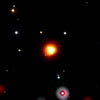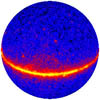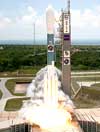News Archive
1996 |
1997 |
1998 |
1999 |
2000 |
2001 |
2002 |
2003
2004 | 2005 | 2006 | 2007 | 2008 | 2009 | 2010 | 2011
2012 | 2013 | 2014 | 2015
2004 | 2005 | 2006 | 2007 | 2008 | 2009 | 2010 | 2011
2012 | 2013 | 2014 | 2015
![]()
Welcome to our archive of past news articles.
You will find previous articles listed below
from most the recent back to our first articles in 1996.
2008
 |
Dark Energy Found Stifling Growth in Universe [17 December 2008] - For the first time, astronomers have clearly seen the effects of "dark energy" on the most massive collapsed objects in the universe using NASA's Chandra X-ray Observatory. Astronomers have tracked how dark energy has stifled the growth of galaxy clusters and combined this with previous studies. By doing so, scientists have obtained the best clues yet about what dark energy is and what the destiny of the universe could be. |
 |
NASA Supercomputer Shows How Dust Rings Point to Exo-Earths [10 October 2008] - Supercomputer simulations of dusty disks around sunlike stars show that planets nearly as small as Mars can create patterns that future telescopes may be able to detect. The research points to a new avenue in the search for habitable planets. |
 |
NASA's Swift Catches Farthest Ever Gamma-Ray Burst [23 September 2008] - NASA's Swift satellite has found the most distant gamma-ray burst ever detected. The blast, designated GRB 080913, arose from an exploding star 12.8 billion light-years away. |
 |
"Naked-Eye" Gamma-ray Burst Was Aimed Squarely at Earth [10 September 2008] - Unparalleled data from satellites and observatories around the globe show that the jet from a powerful stellar explosion March 19 was aimed almost directly at Earth. The event, called a gamma-ray burst, became bright enough for human eyes to see. The observations give astronomers the most detailed portrait of a burst ever made. |
 |
NASA's New View of Gamma-Ray Sky Honors Fermi [27 August 2008] - NASA's newest observatory, the Gamma-Ray Large Area Space Telescope, has been renamed in honor of Enrico Fermi, as NASA released the observatory's first all sky map of the gamma-ray sky. |
 |
NASA's GLAST Launch Successful [12 June 2008] - NASA's Gamma-ray Large Area Space Telescope, or GLAST, successfully launched aboard a Delta II rocket from Cape Canaveral Air Force Station in Florida at 12:05 p.m. EDT on June 11. |
 |
NASA's Swift Satellite Catches Supernova in the Act of Exploding [22 May 2008] - Thanks to a fortuitous observation with NASA's Swift satellite, astronomers for the first time have caught a star in the act of exploding. Astronomers have previously observed thousands of stellar explosions, known as supernovae, but they have always seen them after the fireworks were well underway. |
 |
NASA Scientists Identify Smallest Known Black Hole [02 April 2008] - Using a new technique, two NASA scientists have identified the lightest known black hole. With a mass only about 3.8 times greater than our Sun and a diameter of only 15 miles, the black hole lies very close to the minimum size predicted for black holes that originate from dying stars. |
 |
NASA Satellite Detects Record Explosion Halfway Across Universe [21 March 2008] - A powerful stellar explosion detected March 19 by NASA's Swift satellite has shattered the record for the most distant object that could be seen with the naked eye. |
 |
WMAP Reveals Neutrinos, End of Dark Ages, First Second of Universe [10 March 2008] - NASA released this week five years of data collected by the Wilkinson Microwave Anisotropy Probe (WMAP). These data refine our understanding of the universe and its development. |
 |
NASA's Swift Satellite Catches a Galaxy Ablaze With Starbirth [26 February 2008] - Combining 39 individual frames taken over 11 hours of exposure time, NASA astronomers have created this ultraviolet mosaic of the nearby Triangulum Galaxy. "This is the most detailed ultraviolet image of an entire galaxy ever taken," says Stefan Immler of NASA's Goddard Space Flight Center in Greenbelt, Md. Immler used NASA's Swift satellite to take the images, and he then assembled them into a mosaic that seamlessly covers the entire galaxy. |
1996 |
1997 |
1998 |
1999 |
2000 |
2001 |
2002 |
2003
2004 | 2005 | 2006 | 2007 | 2008 | 2009 | 2010 | 2011
2012 | 2013 | 2014 | 2015
2004 | 2005 | 2006 | 2007 | 2008 | 2009 | 2010 | 2011
2012 | 2013 | 2014 | 2015
Take Me to the News Page

